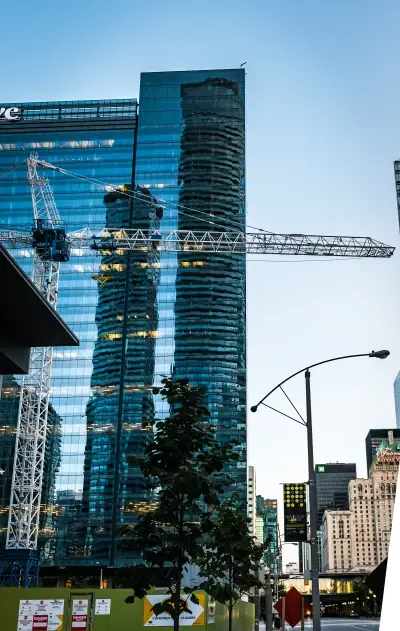Commercial construction loans in California
Building commercial real estate from the ground up requires more than just vision and permits. You need construction financing that understands development timelines, manages cash flow efficiently, and converts seamlessly to permanent financing when your project is complete. For residential development projects, construction-to-permanent loans offer similar benefits for home builders.
We specialize in commercial construction loans that support California developers through every phase of the building process. Our construction-to-permanent financing eliminates the uncertainty of separate construction and permanent loan applications while providing the flexibility successful developments require.
California’s construction market presents unique opportunities and challenges. Strong economic fundamentals drive demand for new commercial space, but complex permitting processes and high construction costs require experienced financing partners who understand local development realities.
Understanding Commercial Construction Financing
Commercial construction loans function differently from traditional real estate financing. Instead of purchasing an existing property, you’re financing the creation of commercial real estate based on plans, projections, and developer experience.
Construction-to-permanent structure eliminates the need for separate construction and permanent financing. Your loan begins as construction financing during the building phase, then automatically converts to permanent financing upon completion. When you need quick interim financing for property acquisition before construction begins, commercial bridge loans provide the speed and flexibility required.
Interest-only payments during construction maximize cash flow when you’re investing heavily in development costs. Principal and interest payments begin only after construction completion and loan conversion.
Draw-based funding releases money as construction progresses rather than providing full funding upfront. This approach protects both lender and borrower by ensuring funds match actual construction progress.
What California Development Environment Factors Affect Commercial Construction?
California’s commercial construction market benefits from strong economic fundamentals but requires navigating complex regulatory environments. Recent legislative changes like AB 2234 have standardized permit approval timelines, making development scheduling more predictable.
Environmental regulations, seismic requirements, and local zoning restrictions add complexity but also create barriers to entry that protect successful developments from excessive competition.
Types of Commercial Construction Projects
Our construction lending covers the full spectrum of commercial development projects across California’s diverse markets. Each project type presents different opportunities and financing considerations.
Office buildings in urban markets often require substantial upfront investment but benefit from strong tenant demand and appreciation potential. Mixed-use projects combining office and retail space capitalize on California’s live-work-play development trends.
Industrial and warehouse facilities have seen exceptional demand growth driven by e-commerce and supply chain considerations. These projects often offer faster construction timelines and strong tenant pre-leasing potential.
Retail developments require careful market analysis but can provide stable long-term cash flows. Successful retail projects often incorporate entertainment, dining, and experiential components that resist online competition.
Mixed-use developments combining residential, commercial, and retail components offer diversification benefits but require sophisticated planning and market analysis.
What Specialized Project Considerations Apply to Commercial Construction Loans?
Each commercial construction project type requires understanding specific market dynamics, tenant requirements, and regulatory considerations.
Ground-up construction allows optimizing building design for intended use, energy efficiency, and long-term operational costs. This advantage often justifies construction costs compared to renovation alternatives. For owner-occupied commercial properties, SBA 504 loans offer attractive permanent financing options with low down payments once construction is complete.
Construction Loan Structure and Terms
Commercial construction loans typically run 12-24 months during the construction phase, then convert to permanent financing with 15-25 year amortization schedules.
Loan-to-cost ratios typically range from 70-80% depending on developer experience and project fundamentals. Strong developers with pre-leased projects may qualify for higher leverage ratios.
Interest rates during construction often float above prime rate, while permanent rates may be fixed or adjustable based on borrower preference and market conditions.
Draw schedules customize to each project’s construction timeline. Typical milestones include foundation completion, framing, roof installation, mechanical systems, and final completion with certificate of occupancy.
How Does Conversion to Permanent Financing Work for Commercial Construction?
The construction-to-permanent structure eliminates requalification uncertainty when your project is complete. Conversion terms are established at initial loan closing, providing rate and payment certainty throughout the development process.
Permanent financing terms reflect completed project performance and market conditions at conversion, often providing better terms than separate permanent financing applications.
Project Qualification Requirements
Construction loan approval depends on evaluating multiple components: developer experience, project viability, market demand, and financial capacity. Each element contributes to overall project risk assessment.
Developer track record demonstrates ability to complete projects on time and within budget. First-time developers may qualify with experienced general contractors and strong financial backing.
Project feasibility examines market demand, competition analysis, and financial projections. Pre-leasing or pre-sale commitments significantly strengthen loan applications.
Construction budget accuracy requires detailed contractor bids, material cost estimates, and realistic timeline projections. Experienced developers provide contingency planning for potential cost overruns.
Financial capacity ensures ability to handle down payment requirements, cost overruns, and carrying costs during construction and lease-up periods.
What Are the Requirements?
California construction projects must navigate state-specific requirements including seismic engineering standards, environmental regulations, and local permit processes.
Recent legislative changes have streamlined some approval processes, but developers still need expert guidance through complex regulatory requirements that vary by county and municipality.
The Construction Draw Process
Construction draws release funding as work progresses and milestones are achieved. This system protects all parties by ensuring funds match actual construction progress and quality standards.
Draw requests typically require contractor invoices, lien waivers, and progress photos or inspections. Most lenders conduct physical inspections before releasing significant draw amounts.
Typical draw schedule might include: 10% at foundation completion, 20% at framing, 15% at roof completion, 20% at mechanical/electrical rough-in, 15% at drywall completion, 10% at final completion, with 10% held for final punch list items.
Inspection coordination involves lender representatives, construction managers, and sometimes third-party inspectors verifying work quality and completion percentages.
Lien waiver management ensures subcontractors and suppliers are paid properly and no mechanics’ liens threaten project completion or permanent financing conversion.
How Long Does the Process Take?
Successful construction financing requires coordinating draw schedules with construction progress and cash flow needs. Experienced developers build buffer time into schedules to handle weather delays, permit revisions, and material delivery issues.
California’s construction seasons and weather patterns affect project scheduling, particularly for exterior work and foundation phases.
Risk Management and Contingencies
Construction projects inherently carry more risk than purchasing existing properties. Successful developers and lenders manage these risks through careful planning, adequate reserves, and experienced team selection.
Cost overrun protection through detailed budgeting, fixed-price contractor agreements where possible, and adequate contingency reserves. Most construction loans require 10-15% contingency funds above base construction costs.
Timeline management involves realistic scheduling, weather contingencies, and permit approval buffers. California’s complex approval processes require building extra time into development schedules.
Market risk affects both construction costs and completed project values. Understanding local market trends and demand drivers helps structure projects that succeed regardless of minor market fluctuations.
Contractor performance risk requires selecting experienced, properly licensed and bonded general contractors with track records in similar projects.
What Quality Control Measures Are Required for Commercial Construction Loans?
Construction loan success depends on maintaining quality standards throughout the building process. Regular inspections, material specifications, and adherence to approved plans protect both project value and permanent financing conversion.
California’s stringent building codes and inspection requirements provide quality assurance but require experienced contractors familiar with local standards. Consider bank statement loans for contractor.
California Market Opportunities
California’s diverse commercial real estate markets offer construction opportunities across property types and geographic regions. Understanding regional market dynamics helps identify optimal development strategies.
Los Angeles County offers substantial development opportunities in emerging neighborhoods and established commercial corridors. High land costs require careful project planning but strong fundamentals support aggressive development strategies.
Orange County markets favor high-quality commercial developments serving affluent demographics. Projects often incorporate premium finishes and amenities that command strong rental rates.
Alameda County (Oakland, Berkeley, Fremont) supports diverse development projects from urban mixed-use to biotech facilities. Strong tenant demand and limited supply drive substantial construction activity despite higher land costs.
Contra Costa County (Walnut Creek, Concord, Richmond) offers lower-cost development opportunities than neighboring counties while maintaining strong demographic fundamentals. Suburban office parks, retail centers, and industrial projects benefit from Bay Area proximity.
Bay Area Peninsula (San Mateo, Santa Clara) construction costs run high but strong tenant demand and limited supply support substantial development investments. Technology sector growth drives demand for modern office and industrial space.
Central Valley markets provide affordable land costs and growing demand driven by companies relocating from coastal markets. These areas often offer excellent development returns for properly structured projects.
What Regional Development Trends Drive Commercial Construction in California?
Each California region presents different development opportunities based on economic drivers, demographic trends, and regulatory environments.
Industrial development has seen particular strength throughout California driven by e-commerce growth and supply chain considerations. Office development focuses on modern, flexible spaces that accommodate changing workplace preferences.
Working with Development Teams
Successful commercial construction requires assembling experienced teams including architects, engineers, general contractors, and specialty consultants. California projects often require additional specialists for seismic engineering and environmental compliance.
Architect selection should prioritize commercial experience, familiarity with local codes, and understanding of your intended tenant requirements. Experienced architects help navigate permit processes and optimize building efficiency.
General contractor evaluation focuses on commercial construction experience, proper licensing and bonding, financial stability, and track record with similar projects. Self-employed contractors seeking financing can explore bank statement loans when traditional income documentation proves challenging.
Engineering consultants for structural, mechanical, electrical, and civil engineering must understand California’s specific requirements including seismic standards and environmental regulations.
How Does Professional Relationship Management Benefit Commercial Construction Projects?
Long-term development success often depends on building relationships with reliable professional teams. Experienced developers maintain preferred vendor lists that support consistent project execution.
We work with developers to evaluate team qualifications and ensure all professionals meet lender requirements for licensing, bonding, and insurance coverage.
Clarity First, Numbers Later
Construction loan pricing varies significantly based on project complexity, developer experience, and current market conditions. Rather than quote rates that change with market fluctuations, we focus on helping you understand what drives your construction loan terms.
Project risk assessment affects pricing through factors like development experience, market demand, pre-leasing status, and construction complexity. Developer track record influences both approval odds and final terms.
Market conditions impact both construction loan availability and permanent financing options at conversion.
Strategic Development Planning
Successful commercial developers use construction financing strategically as part of broader investment and development strategies. Understanding when construction makes sense compared to renovation or acquisition helps optimize your approach.
Market timing considerations include construction costs, permit approval timelines, and anticipated market conditions at project completion. Portfolio strategy often involves balancing ground-up development with acquisition opportunities.
Exit strategy planning ensures your completed project meets permanent financing requirements and market demand expectations.
Next Steps
Every commercial construction project presents unique challenges and opportunities. If you’re considering ground-up development, the most important step is understanding your project’s specific financing requirements and timeline considerations.
Our commercial construction lending team specializes in California development projects and understands both construction phase management and permanent financing conversion. We’ll analyze your development plans and recommend financing approaches that support successful project completion.
California’s commercial development opportunities continue providing strong returns for experienced developers with proper financing support. Call (510) 589-4096 to discuss your development project or view all commercial financing programs.
Explore More Commercial Financing
Not sure if construction financing fits your situation? Compare our other commercial financing programs including bridge loans (quick acquisition), SBA loans (low down payments), conventional commercial loans (long-term stability), and DSCR loans (investor properties) to find the perfect fit for your California business.


